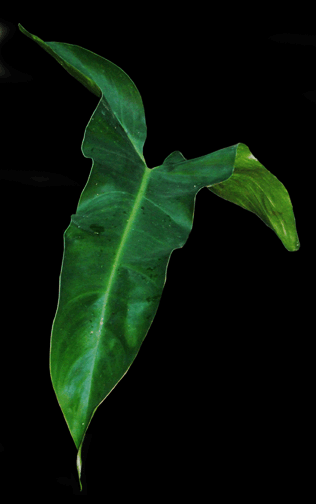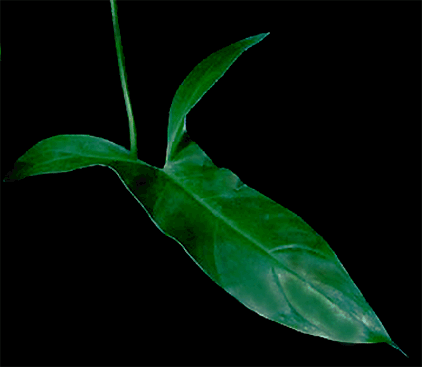![]()
Aroids and other genera in the Collection
Take the Tour Now?
Orchids
The
Exotic Rainforest
Plants in
the Exotic Rainforest Collection
Images on this website are copyright protected. Contact
us before attempting to reuse.
In depth information on how to grow Philodendron species, Click this Link
Within our collection we have many species of Philodendron. If you are seeking other photos, click this link
Philodendron mexicanum Engl.

Synonym: Philodendron latisagittium
 Identified to
science in 1878
by botanist Heinrich
Gustav Adolf Engler (1844 to 1930), Philodendron mexicanum is a tree climber
normally found in Mexico's humid rain forests at elevations of
approximately 1200 meters (3700 feet), Philodendron mexicanum is
native to Mexico's Chiapas region, however, the
aroid
ranges from Mexico south through Central America including
Guatemala, Honduras, Panama, Costa Rica and into Colombia and
Ecuador. It can be found from near sea level to as high as 1900 meters (almost
6000 feet) in both rain forests and dry habitats, especially in
west-central Mexico.
Identified to
science in 1878
by botanist Heinrich
Gustav Adolf Engler (1844 to 1930), Philodendron mexicanum is a tree climber
normally found in Mexico's humid rain forests at elevations of
approximately 1200 meters (3700 feet), Philodendron mexicanum is
native to Mexico's Chiapas region, however, the
aroid
ranges from Mexico south through Central America including
Guatemala, Honduras, Panama, Costa Rica and into Colombia and
Ecuador. It can be found from near sea level to as high as 1900 meters (almost
6000 feet) in both rain forests and dry habitats, especially in
west-central Mexico.
With its "dog eared" narrowly triangular semi-glossy leaf blades, Philodendron mexicanum is said to often grow draped across humid rain forest rocks. Philodendron mexicanum has coriaceous (leathery) arrow shaped leaves with unequal basal lobes which makes the leaf almost appear to be three leaves due to the upper appendages. The leaves are magenta to maroon on the underside of the blades.
When
Philodendron mexicanum produces an inflorescence it produces a small green spathe
appearing to
be a hood
with a ruby interior.
That inflorescence is not a "flower". The true flowers
are found along the spadix which is the center portion of
the inflorescence. In Philodendron species the
flowers are very tiny and require a magnifying tool to observe. Production of an inflorescence occurs in the mid-dry and
early rainy season from February through May.
Philodendron mexicanum has been
observed to produce an inflorescence twice a year in captive growth. 
Philodendron mexicanum grows both as a terrestrial plant and as an epiphyte (ep-a-FIT) on the sides of trees. An epiphyte is simply a species that grows upon another plant. Experienced growers recommend not to over water this plant and plant it in very well draining loose soil with plenty of peat and Perlite™ added. We also throw in a healthy helping of orchid bark to give the roots something to attach themselves to and for additional drainage. The species is easy to grow and our specimen shown above has reached a total height of well over 2 meters in under two years.
Philodendron species, especially hybrid forms, are known to be highly variable and not every leaf of every specimen will always appear the same. This link explains natural variation and morphogenesis within aroid species. Click here.
Want to learn more
about aroids?
Join the
International Aroid Society:
http://www.exoticrainforest.com/Join%20IAS.html